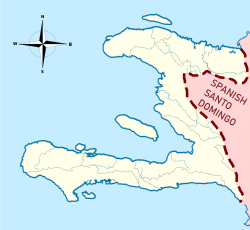
Back سانتو دومينغو (مستعمرة فرنسية) Arabic Saint-Domingue Breton Saint-Domingue Catalan Saint-Domingue Czech Saint-Domingue Danish Saint-Domingue German Saint-Domingue Spanish Saint-Domingue Basque Saint-Domingue Finnish Saint-Domingue (colonie française) French
Saint-Domingue | |||||||||||
|---|---|---|---|---|---|---|---|---|---|---|---|
| 1697–1804 | |||||||||||
 | |||||||||||
| Status | Colony of France | ||||||||||
| Capital | Cap-Français (1711–1770) Port-au-Prince (1770–1804) 19°6′0″N 72°20′0″W / 19.10000°N 72.33333°W | ||||||||||
| Common languages | French, Creole French, American English | ||||||||||
| Religion | Roman Catholicism, Sunni Islam, Haitian Vodou | ||||||||||
| Demonym(s) | Creole | ||||||||||
| King | |||||||||||
• 1697-1715 | Louis XIV | ||||||||||
• 1715–1774 | Louis XV | ||||||||||
• 1774-1792 | Louis XVI | ||||||||||
| Governor General | |||||||||||
• 1697–1700 | Jean Du Casse (first) | ||||||||||
• 1803–1804 | Jean Jacques Dessalines (last) | ||||||||||
| History | |||||||||||
| 1697 | |||||||||||
| 1 January 1804 | |||||||||||
| Area | |||||||||||
• Total | 21,550 km2 (8,320 sq mi) | ||||||||||
| Currency | Saint-Domingue livre | ||||||||||
| |||||||||||
| Today part of | Haiti | ||||||||||
| History of Haiti |
|---|
| Pre-Columbian Haiti (before 1492) |
| Captaincy General of Santo Domingo (1492–1625) |
| Taíno genocide |
| Saint-Domingue (1625–1804) |
| First Empire of Haiti (1804–1806) |
| North Haiti (1806–1820) |
| South Haiti (1806–1820) |
| Republic of Haiti (1820–1849) |
| Second Empire of Haiti (1849–1859) |
| Republic of Haiti (1859–1957) |
| Duvalier dynasty (1957–1986) |
| Anti-Duvalier protest movement |
| Republic of Haiti (1986–present) |
| Timeline |
| Topics |
|
|
Saint-Domingue (French pronunciation: [sɛ̃ dɔmɛ̃ɡ] ⓘ) was a French colony in the western portion of the Caribbean island of Hispaniola, in the area of modern-day Haiti, from 1697 to 1804. The name derives from the Spanish main city on the island, Santo Domingo, which came to refer specifically to the Spanish-held Captaincy General of Santo Domingo, now the Dominican Republic. The borders between the two were fluid and changed over time until they were finally solidified in the Dominican War of Independence in 1844.
The French had established themselves on the western portion of the islands of Hispaniola and Tortuga by 1659. In the Treaty of Ryswick of 1697, Spain formally recognized French control of Tortuga Island and the western third of the island of Hispaniola.[1][2] In 1791, slaves and some Creoles took part in a Vodou ceremony at Bois Caïman and planned the Haitian Revolution.[3] The slave rebellion later allied with Republican French forces following the abolition of slavery in the colony in 1793, although this alienated the island's dominant slave-owning class. France controlled the entirety of Hispaniola from 1795 to 1802, when a renewed rebellion began. The last French troops withdrew from the western portion of the island in late 1803, and the colony later declared its independence as Haiti, the Taino name for the island, the following year.
- ^ "Hispaniola Article". Britannica.com. Retrieved 4 January 2014.
- ^ Henson, Janine (12 February 2014). "Dominican Republic 2014". CardioStart International. Retrieved 24 April 2014.
- ^ McAlister, Elizabeth (2012). "From Slave Revolt to a Blood Pact with Satan: The Evangelical Rewriting of Haitian History". Studies in Religion/Sciences Religieuses. 41 (2): 187–215. doi:10.1177/0008429812441310. S2CID 145382199.

